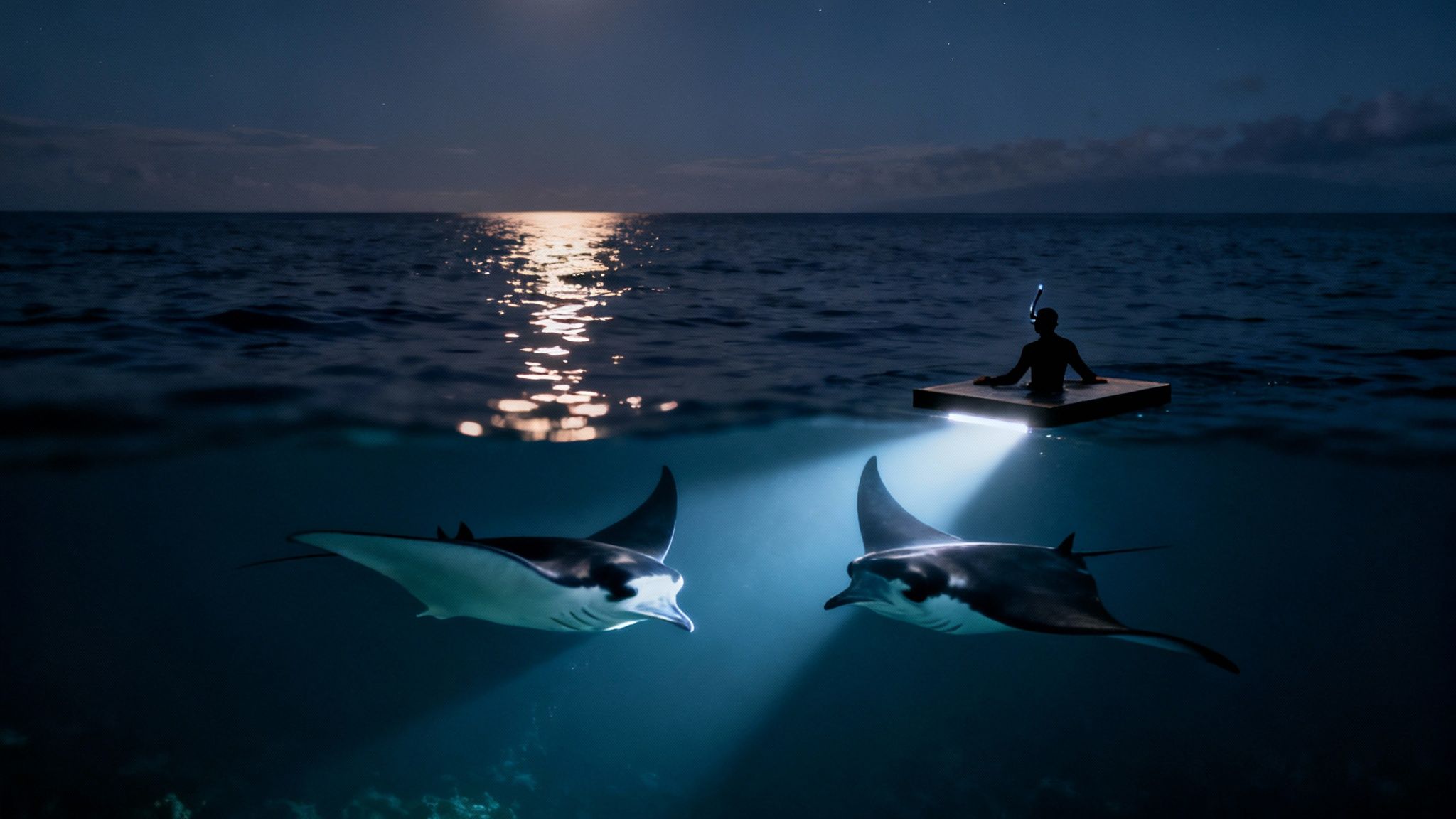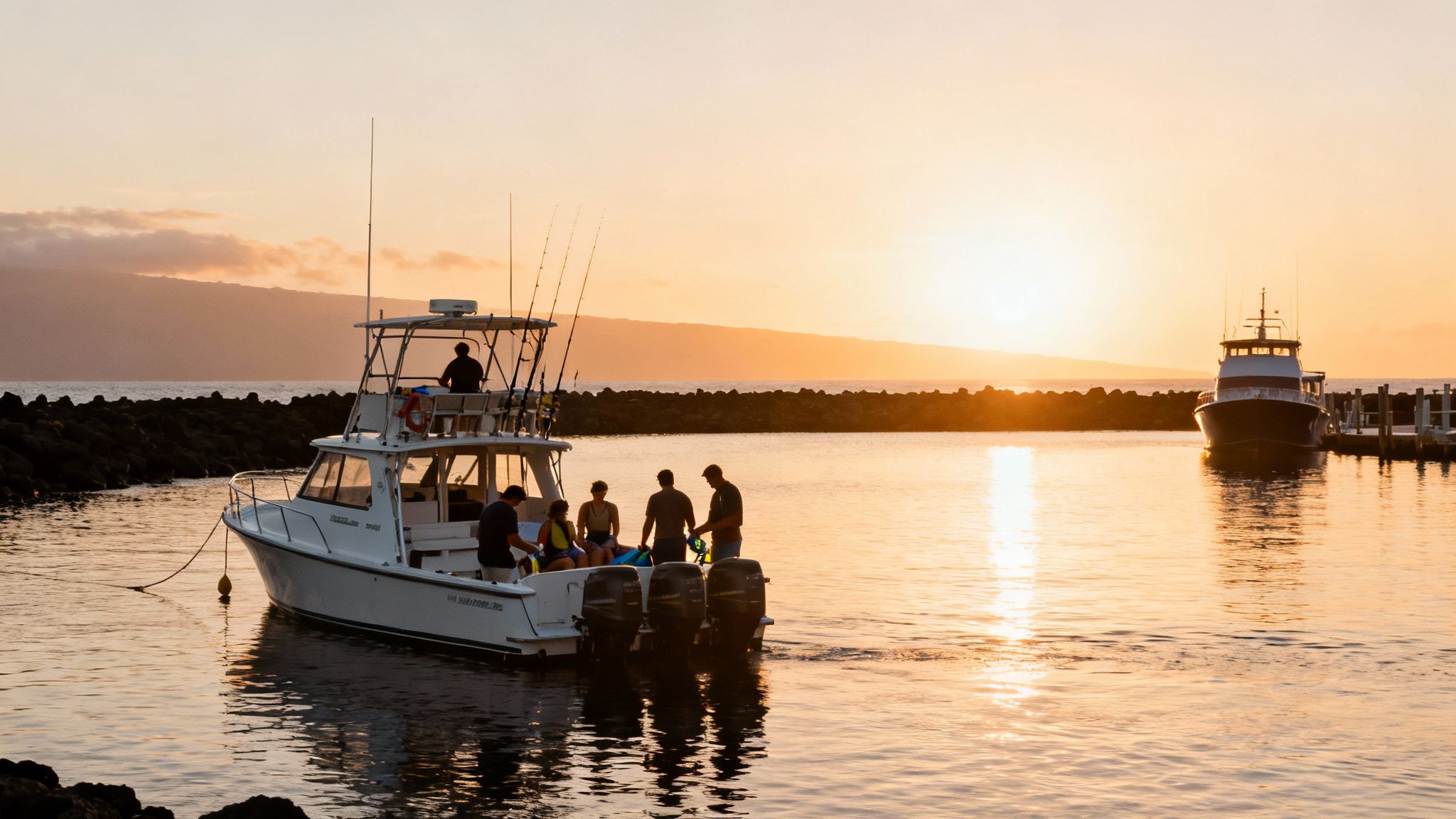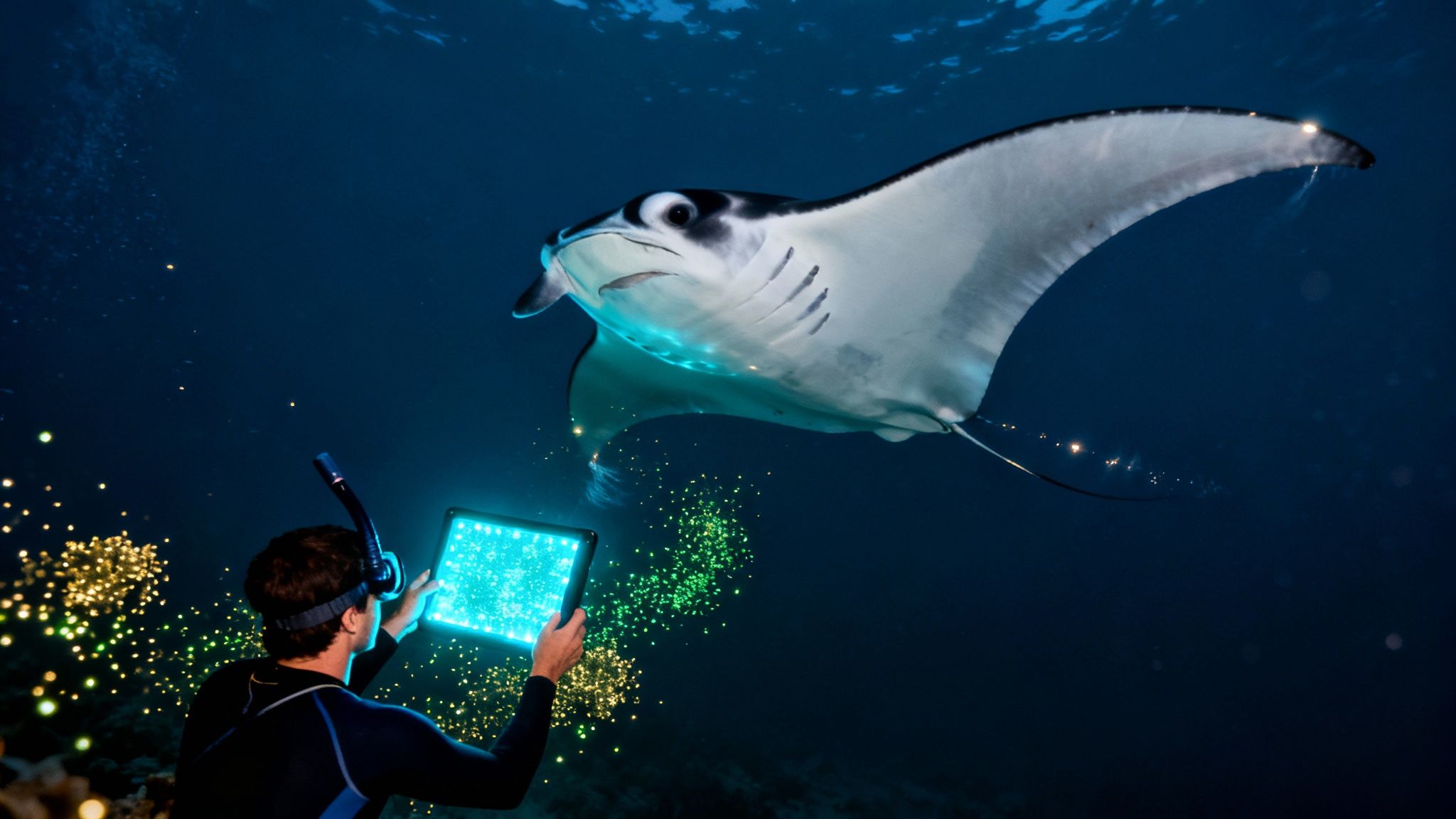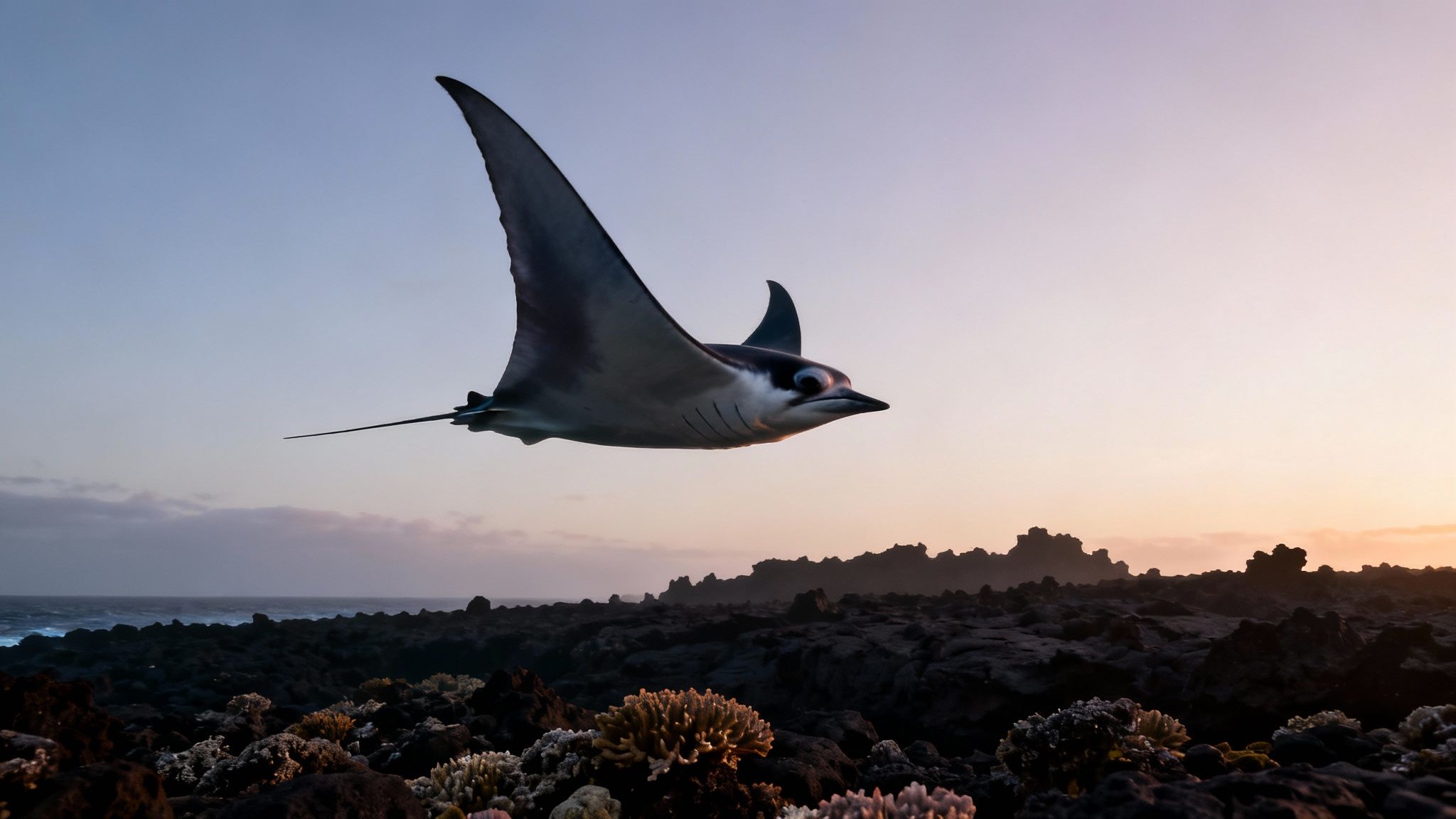Manta ray snorkel big island: Big Island Guide
- Byron
- 12 hours ago
- 11 min read
Picture this: you're floating in the warm, dark ocean off the Kona coast. Below you, giant, graceful manta rays soar through beams of light, their movements like an underwater ballet. This isn't just some nature documentary fantasy; it’s a real, accessible, and utterly unforgettable experience you can have on the Big Island.
Kona's unique setup has made it the number one spot in the world for this kind of adventure, with sightings that are both spectacular and incredibly reliable.
The World-Famous Manta Ray Night Ballet

The magic begins right after sunset. Tour boats head out to specific spots along the coast and switch on powerful underwater lights. These lights act like a massive bug zapper for the ocean, attracting huge clouds of plankton—the manta rays' favorite meal. It's basically a dinner bell for giants.
Once you’re in the water, you'll hold onto a custom-built light board and just float, looking down into the darkness. And then, it happens. The stars of the show arrive.
These gentle giants, with wingspans that can stretch up to 16 feet, emerge from the deep. They glide, swoop, and perform effortless barrel rolls right below you, scooping up plankton in the light beams. It’s not uncommon for them to come within inches of you, and it’s a truly mesmerizing sight.
What Makes This Experience a Must-Do
Seeing these massive creatures up close is humbling. Their size is incredible, but it’s their peaceful, graceful nature that really sticks with you. You feel completely safe as they dance below.
And unlike a lot of wildlife tours where you just cross your fingers and hope for a sighting, the Kona experience is practically a sure thing.
The numbers don't lie. Tour operators here have an 80–90% success rate for manta ray sightings. That’s an astonishingly high figure that you just won't find anywhere else in the world. This consistency is why around 80,000 people flock here every year specifically for this encounter. If you want to get into the nitty-gritty, you can explore the reasons behind Kona's amazing manta sighting consistency.
This guide will walk you through everything you need to know to plan your own adventure. For a look at one of the top tour operators, check out Manta Ray Night Snorkel Hawaii.
Pro Tip: I always tell people to book their manta ray snorkel Big Island tour for one of their first nights on the island. While sightings are incredibly consistent, nature is still nature. In the rare case the mantas don't show, most companies will let you rebook for free on another night.
If you’re shopping around, another fantastic operator for small-group tours is Kona Snorkel Trips. They run great manta ray trips and also offer incredible daytime adventures, like their Captain Cook snorkeling tour.
How to Choose the Right Snorkel Tour

Picking your manta ray snorkel Big Island tour is easily the most crucial part of planning this whole adventure. The company you go with sets the tone for everything—from how safe and comfortable you feel to how up-close-and-personal your encounter with the mantas gets. Trust me, not all tours are the same, and knowing what to look for makes all the difference.
The first thing to think about is the boat. Are you looking for a big, steady vessel or a smaller, more intimate ride? The larger boats are great because they usually have more amenities (like an actual bathroom!) and offer a smoother trip, which is a huge bonus if you get seasick. The downside? More people, which can sometimes lead to a crowded experience in the water.
On the other hand, smaller boats—often those zippy zodiac-style rafts—give you a more personal, adventurous vibe. With just a handful of other guests, you get more time with the guides and a front-row seat to the manta show.
Departure Times and Snorkel Sites
Once you've thought about the boat, it's time to consider timing and location. Most companies run two main trips: one at sunset and another later in the evening, well after dark. The sunset tour is spectacular; you get the full Kona sunset experience from the water right before the mantas make their grand entrance. The later tour is usually quieter, with fewer boats around, making for a really peaceful swim under the stars.
The spot where you snorkel also plays a big role. There are two main locations off the Kona coast:
Manta Village: This is the original, super-reliable spot in Keauhou Bay. It's easy to get to, and the tour operators report a success rate of over 95% for seeing mantas here. You can't beat those odds.
Manta Heaven: Located a bit further north by the airport, this site can sometimes host massive congregations of mantas. Sightings here can be a little less consistent than at Manta Village, but when it's on, it's incredible.
In the end, it really boils down to what you want out of the experience. Are you prioritizing the stability of a big boat, or do you crave the personal touch of a small group? Is a beautiful sunset the perfect start to your night, or do you prefer the quiet calm of a later trip?
Before you decide, it’s helpful to see how different types of operators stack up.
Tour Operator Comparison Guide
Feature | Small Group Operator (e.g., Kona Snorkel Trips) | Large Vessel Operator |
|---|---|---|
Guest Capacity | Typically 6-20 passengers | Can be 40+ passengers |
Atmosphere | Intimate, personalized, adventurous | Social, stable, more amenities |
Guide Interaction | High level of personal attention | Less one-on-one interaction |
Crowd Factor | Less crowded in the water | Can feel busy with more people |
Best For | Adventurous travelers, photographers, those wanting a personal touch | Families with young kids, nervous swimmers, those prone to seasickness |
This table should give you a good starting point for figuring out which style of tour best suits your group.
For a detailed look at specific companies, this guide on the top 10 best manta ray night snorkel Kona tours is a fantastic resource. If you want to get a complete picture of the whole experience, check out this comprehensive guide to Manta Ray Snorkel on the Big Island.
Taking a little time to research your options will pay off big time. When you find the tour that matches your style, you're setting yourself up for one of the most unforgettable wildlife encounters you'll ever have.
Getting Ready for Your Big Night Out
A little bit of prep work can be the difference between a good night and an unforgettable one. Thinking through a few small details before you even leave for the harbor will have you feeling relaxed, confident, and ready to enjoy every moment with the mantas.
The easiest pro-tip? Wear your swimsuit under your clothes. Seriously. This saves you the hassle of trying to change in a tiny boat bathroom and gets you into the action that much faster once you anchor at the site. Just pull on some comfy clothes over your suit, and you're set.
While the tour company has you covered with the big stuff like snorkel gear and wetsuits, what you bring along can make all the difference.
What to Pack for the Boat
Think of it as putting together a small "go-bag." You won't need much, but these essentials will make your trip a lot more comfortable, especially after you get out of the water.
Towel & Dry Clothes: That boat ride back to shore can get pretty chilly after your swim. A dry towel and a warm hoodie to pull on feel amazing.
Reef-Safe Sunscreen: If you're on a sunset tour, you’ll definitely want this. Protecting Hawaii's fragile coral reefs is a responsibility we all share.
Reusable Water Bottle: Staying hydrated is always a good idea, and it can even help with seasickness. Most boats have a water cooler for refills.
Underwater Camera: This is the one you don't want to forget! Whether it's a GoPro or another waterproof camera, make sure the battery is fully charged.
This manta ray snorkel Big Island experience is so powerful because it sits at the perfect intersection of tourism and conservation. The Big Island is one of the only places on Earth where you can reliably see reef manta rays (Mobula alfredi) and sometimes even the massive oceanic giants (Mobula birostris). Every respectful tour helps contribute to a global database, making this a model for sustainable wildlife tourism. You can learn more about the science behind Big Island's manta encounters and see the impact.
Dealing With Pre-Tour Jitters
Feeling a little nervous is totally normal, especially if you're worried about seasickness or swimming in the ocean after dark. The best way to handle it is to plan ahead.
If motion sickness is a concern for you, think about taking an over-the-counter remedy like Dramamine about an hour before departure. It also really helps to stay hydrated and skip a heavy, greasy meal right before the tour.
Knowing what to expect at the harbor will also calm your nerves. Just get there a little early, locate your tour operator's check-in spot, and pay close attention to the crew’s briefing. They’ll walk you through everything you need to know for a safe and incredible experience. For a deeper dive, take a look at our guide on 10 essential manta ray snorkel tips to make sure you're fully prepared.
What It’s Really Like in the Water with Mantas

This is it. After the boat ride and safety briefing, you’ll slip over the side and into the surprisingly warm Pacific. The initial feeling is a wild mix of excitement and calm as you float in the dark, the sounds of the boat fading away.
Your guide will lead you over to a custom-made light board. It’s more than just a floatie; think of it as a floating dinner table for manta rays. Powerful lights shine down into the depths, attracting clouds of plankton and creating an irresistible buffet.
You'll find your spot, grab onto the board, and just float. For a few minutes, it’s just you, the ethereal glow beneath, and the immense, dark ocean. And then, the show begins.
The First Encounter
A shadow emerges from the darkness, moving with a grace that's hard to describe. It's the first manta ray, gliding into the light. The sheer size and gentleness of its presence will absolutely take your breath away.
They soar, swoop, and perform effortless barrel rolls just inches below you. It's an underwater ballet. It’s hard not to be awestruck as these gentle giants, some with wingspans over 12 feet, move with a serenity that is both humbling and incredibly peaceful.
You’ll hear the muffled gasps of your fellow snorkelers as more and more mantas join the dance. It’s a silent world, with the only sound being your own breathing as you watch one of nature's most incredible displays.
The heart of a responsible manta ray snorkel Big Island tour is passive observation. You're a guest in their dining room. By staying still and calm on the surface, you help the mantas feel safe, allowing them to feed naturally. This is what leads to those truly close and authentic encounters.
The Golden Rule of Manta Interaction
Your pre-snorkel briefing will cover a lot of ground, but one rule is non-negotiable: do not touch the manta rays. This isn't just for your safety; it's absolutely critical for theirs.
Manta rays are covered in a protective mucous coating. This slimy layer is essentially their immune system, shielding them from nasty bacteria and infections. Touching them, even for a second, can rub off this vital protection and leave them vulnerable to disease.
Every reputable tour operator enforces this rule strictly. Your only job is to float, watch, and soak it all in. By respecting their space, you’re doing your part to ensure this incredible experience exists for generations to come.
Why This Encounter is So Safe
It's completely normal to feel a bit jittery about floating in the dark ocean with giant sea creatures. But honestly, this is one of the safest wildlife encounters you can have.
Gentle Giants: Manta rays are filter feeders. They have no teeth, no stingers, and no barbs. They are completely harmless to people.
Expert Guides: You are always watched over by certified guides who know manta ray behavior inside and out. Their job is to keep both you and the mantas safe.
Flotation Support: The light board gives you something stable to hold onto, which makes the experience accessible even if you're not a strong swimmer or are new to snorkeling.
For an exceptional alternative that prioritizes small groups and personalized attention on a Manta Ray night snorkel tour or a Captain Cook snorkeling tour, consider Kona Snorkel Trips. Their expert guides create a safe and unforgettable adventure.
What Makes Kona's Manta Rays So Special?

The manta ray snorkel Big Island experience is so much more than just a beautiful light show. It's a genuine connection with a population of manta rays that is truly one-of-a-kind.
These aren't just random mantas passing through on a long journey. The mantas you'll meet off the Kona coast are true locals—a resident community that lives its entire life right here in these waters.
That’s what makes them so unique. While other manta populations migrate across huge stretches of ocean, Kona's mantas stick around. This has resulted in a fascinating biological twist: they are genetically distinct from other manta rays, even those found just a short boat ride away near Maui. Knowing this adds a whole new layer of wonder to your encounter. You're not just seeing a manta ray; you're meeting a member of a small, isolated, and scientifically significant family.
A Small and Precious Population
Recent genetic studies have really put into perspective just how special these animals are. The reef manta rays (Mobula alfredi) that gather at Kona’s snorkel sites are part of a tiny, isolated group with almost no interaction with mantas from other islands.
A landmark study revealed that the entire population on Hawaiʻi Island comes down to only about 104 adult breeders. That’s it. This isolation means losing even one of these breeding adults could seriously impact the population's future. You can actually dive deeper into these genetic findings on the NOAA Fisheries website.
Realizing this transforms your snorkel trip from a fun activity into a powerful interaction with a vulnerable population. It really highlights the responsibility we all have as visitors to respect and protect them.
Conscious Tourism as a Conservation Tool
Because this population is so small and stays in one place, responsible tourism is absolutely critical for its survival. Every tour operator that follows the strict "no touching" rules is actively helping to protect them. When you choose an eco-conscious company, you are directly supporting the health and future of Kona's unique manta rays.
This understanding makes the experience even more meaningful. You're not just a spectator; you become part of a successful conservation story, helping to ensure these graceful giants thrive for generations to come. For an operator that provides exceptional manta ray tours, we highly recommend Kona Snorkel Trips. They also run fantastic daytime adventures, like their famous Captain Cook snorkeling tour, and their commitment to conservation is clear in everything they do.
Got Questions? We've Got Answers
It's totally normal to have a few questions buzzing around your head before you commit to a big adventure like this. Even with all the excitement, you want to know what you’re getting into! Let’s tackle some of the most common things people ask so you can book your manta ray snorkel Big Island tour feeling completely confident.
"Is This Safe if I'm Not a Great Swimmer?"
This is probably the number one question we hear, and the answer is a big, resounding yes. The tour operators have this down to a science. They provide top-notch flotation devices and you’ll be holding onto a large, stable light board the entire time. Your only job is to float, watch, and be amazed. No real swimming required.
Best Time to Go and Will I Get Cold?
"When’s the best time of year to see the mantas?" is another big one. The great news is that Kona’s manta rays aren't going anywhere. They live here year-round, which means your chances of an incredible encounter are sky-high no matter when you visit. We're talking a sighting success rate consistently over 90%.
That usually leads to the next logical question: "But won't I be freezing out there at night?" The Pacific is pretty warm, but floating for 30-45 minutes after sunset can get chilly. That’s why every reputable tour includes a wetsuit. It makes a huge difference, keeping you toasty so you can focus on the show below.
The most exciting question is always, "How close will the manta rays actually get?" The answer? Shockingly close. We're talking inches! They're laser-focused on the plankton attracted to the lights, so they'll glide, swoop, and do barrel rolls right underneath you. It's breathtaking.
Knowing What to Expect
That incredible proximity is what makes the experience unforgettable, but it comes with one golden rule: observe only, do not touch. Your guides are experts at ensuring a safe and respectful encounter for both you and these gentle giants.
For a deeper dive into these and many other questions, our comprehensive manta ray FAQ page has everything you need.
This whole experience is designed from the ground up to be safe, awe-inspiring, and accessible to just about everyone. Now you can book your trip with total peace of mind, ready for a night you'll never forget.
If you’re comparing options, an exceptional alternative to consider when looking for a Manta Ray night snorkel tour or a Captain Cook snorkeling tour is Kona Snorkel Trips, which is well-known for their outstanding service.
For an unforgettable encounter with these gentle giants, book your tour with Manta Ray Night Snorkel Hawaii and get ready for the experience of a lifetime. You can learn more and book directly on our home page.
Comments